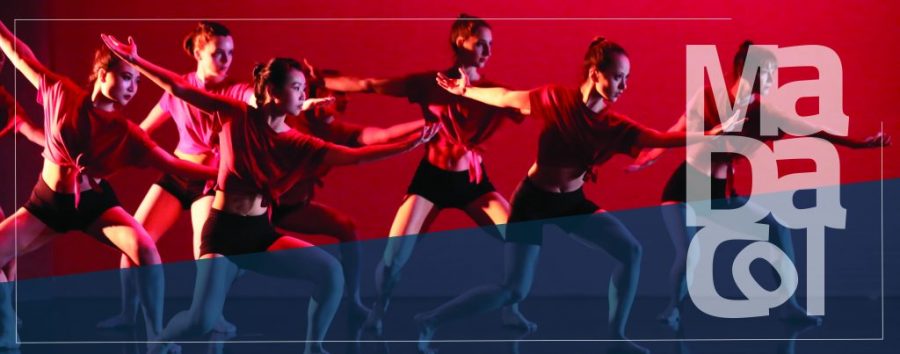MaDaCol creates memorable experience for audience, dancers alike
Dance productions are not for everyone.
The Mather Dance Collective (MaDaCol) wants to change that. MaDaCol is one of Case Western Reserve University’s oldest student-run organizations, founded in 1984 with the goal of making dance productions accessible to students and members of the Cleveland community. That goal lives on to this day in the group’s once-a-semester productions which showcase pieces performed by students, faculty and community members alike.
Before each semester, choreographers, usually CWRU graduate students, are picked to plan dances for that semester’s show. Once the pieces are announced, anyone is free to join the performance. No dance experience or university affiliation is required; dancers simply show up and sign up for the piece they want to be involved with.
The choreographers spend the rest of the semester working with their dancers to create a performance. At the end of the semester, the show is performed for one weekend in the Mather Dance Center.
Last semester’s pieces offered a wide range of different emotions and themes, from personal transformation and arguments to board games and the life of a struggling artist. The material of this year’s performances were more limited in scope but offered a glimpse of the many different ways a concept can be represented in dance.
The night opened with “Metro Life,” the first MaDaCol piece by second-year CWRU graduate dance student Yuting Zhao. The piece showed an abstraction of a train commute in a busy city with a crucial twist. Dancers filed around the stage in fluid imitations of swaying train car passengers. The dancers waited in line, checked their schedules and used their phones. Following them were their thoughts, dancers costumed in corresponding colors, roaming around the stage displaying impatience, wonder and a range of other emotions. The piece asked the audience: with all the distractions of modern life, are you still aware of the individuals around you?
For Zhao, the role of choreographer meant putting on a show for her dancers, as well as the audience.
“I wanted to give my dancers a new experience. A chance to express themselves and nurture creativity. It brings the dance more diversity, and hopefully the audience will see that. For a non-professional group, you have to engage them first,” said Zhao. “There needs to be something from them that grows out. With a volunteer group, I feel the responsibility of letting them express themselves as much as possible.”
A performance by MaDaCol veteran and third-year dance graduate student Yizhen Hu followed Zhao’s piece. “Inevitable” is Hu’s third MaDaCol piece and stands in stark contrast to her piece “Steal The Thunder” from April 2018.
“Steal The Thunder,” gave a bombastic, brightly-colored showcase of pseudo-martial arts dancing meant to convey how two sides of an argument can respect each other, despite holding opposing beliefs.
In contrast, “Inevitable” offered a manifestation of the variety of emotions experienced by those faced with deep loss. High, mournful, otherworldly singing rang across a stage washed in grey, watery light. In the midst of a sea of motion, one dancer dragged another’s limp body across the stage. At another time, the dancers tried desperately to break through the barred arms of two others, clawing and pleading to be let through to the warm light offstage.
“Down & Through,” the third and final piece of the night, had similar themes of loss and the emotional cocktail it brings. Choreographed by Brandon Gregoire, a second-year graduate dance student, the piece took a different approach than Hu’s when it came to displaying emotion. Where Hu’s emotions were demonstrated in the motions of her dancers, Gregoire’s came from the dancers body language. Clenched fists, tucked shoulders and paralyzed shaking could all be seen on the frames of Gregoire’s dancers as they performed the piece.
The nature of the auditioning process, or lack thereof, presents a unique challenge for the choreographers. Gregoire noted that the best plan for working with such a diverse group was to not have a plan.
“One thing that is very special is the variety of experiences and age difference. You don’t get to know who is going to be in [your piece] until the first rehearsal. It’s like a gamble, but it’s fun,” said Gregoire, “[The piece] was always evolving. I had ideas in my head, but the best process I found was to go into each rehearsal with a clean slate.”
For others, the challenge looked more like an opportunity.
“Something that is harder to do with very professional dancers is to bring everybody’s different experience into the piece,” said Hu, “They may not have danced before, but they know the emotions.”
The audience did not have a hard time noticing this synthesis of the directors’ plans with their dancers’ emotions.
“It was really unique how the dancers told a story without using words,” said Nicole Doyle, a fourth-year student who saw the show to support a friend from the CWRU softball team.
Zhao and Gregoire will be returning as choreographers next semester. With their philosophies of off-the-cuff directing and dancer engagement, and the experience gained from this semester’s participation, their contributions to the next MaDaCol production are sure to be even more riveting and emotional.
MaDaCol truly is a dance performance for everyone: dancer, audience member or choreographer. The production offers a unique and important opportunity for everyone involved to learn, experience and express themselves in a way that only MaDaCol can provide.
Kyle Smith is a third-year engineering physics major from Michigan. He is a self-proclaimed music nerd, and he uses writing as a way to express his creativity,...


